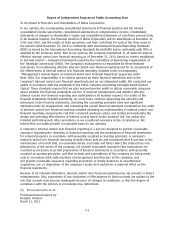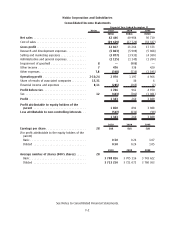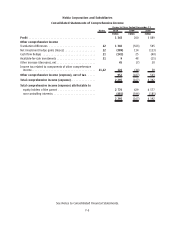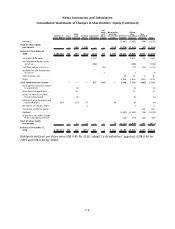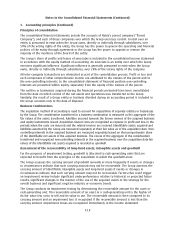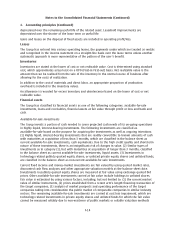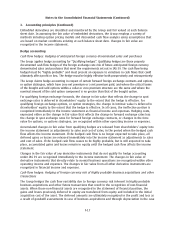Nokia 2010 Annual Report Download - page 198
Download and view the complete annual report
Please find page 198 of the 2010 Nokia annual report below. You can navigate through the pages in the report by either clicking on the pages listed below, or by using the keyword search tool below to find specific information within the annual report.1. Accounting principles (Continued)
Principles of consolidation
The consolidated financial statements include the accounts of Nokia’s parent company (“Parent
Company”), and each of those companies over which the Group exercises control. Control over an
entity is presumed to exist when the Group owns, directly or indirectly through subsidiaries, over
50% of the voting rights of the entity, the Group has the power to govern the operating and financial
policies of the entity through agreement or the Group has the power to appoint or remove the
majority of the members of the board of the entity.
The Group’s share of profits and losses of associates is included in the consolidated income statement
in accordance with the equity method of accounting. An associate is an entity over which the Group
exercises significant influence. Significant influence is generally presumed to exist when the Group
owns, directly or indirectly through subsidiaries, over 20% of the voting rights of the company.
All intercompany transactions are eliminated as part of the consolidation process. Profit or loss and
each component of other comprehensive income are attributed to the owners of the parent and to
the noncontrolling interests. In the consolidated statement of financial position noncontrolling
interests are presented within equity, separately from the equity of the owners of the parent.
The entities or businesses acquired during the financial periods presented have been consolidated
from the date on which control of the net assets and operations was transferred to the Group.
Similarly, the result of a Group entity or business divested during an accounting period is included in
the Group accounts only to the date of disposal.
Business Combinations
The acquisition method of accounting is used to account for acquisitions of separate entities or businesses
by the Group. The consideration transferred in a business combination is measured as the aggregate of the
fair values of the assets transferred, liabilities incurred towards the former owners of the acquired business
and equity instruments issued. Acquisitionrelated costs are recognized as expense in profit and loss in the
periods when the costs are incurred and the related services are received. Identifiable assets acquired and
liabilities assumed by the Group are measured separately at their fair value as of the acquisition date. Non
controlling interests in the acquired business are measured separately based on their proportionate share
of the identifiable net assets of the acquired business. The excess of the aggregate of the consideration
transferred and recognized noncontrolling interests in the acquired business over the acquisition date fair
values of the identifiable net assets acquired is recorded as goodwill.
Assessment of the recoverability of longlived assets, intangible assets and goodwill
For the purposes of impairment testing, goodwill is allocated to cashgenerating units that are
expected to benefit from the synergies of the acquisition in which the goodwill arose.
The Group assesses the carrying amount of goodwill annually or more frequently if events or changes
in circumstances indicate that such carrying amount may not be recoverable. The Group assesses the
carrying amount of identifiable intangible assets and longlived assets if events or changes in
circumstances indicate that such carrying amount may not be recoverable. Factors that could trigger
an impairment review include significant underperformance relative to historical or projected future
results, significant changes in the manner of the use of the acquired assets or the strategy for the
overall business and significant negative industry or economic trends.
The Group conducts its impairment testing by determining the recoverable amount for the asset or
cashgenerating unit. The recoverable amount of an asset or a cashgenerating unit is the higher of
its fair value less costs to sell and its value in use. The recoverable amount is then compared to its
carrying amount and an impairment loss is recognized if the recoverable amount is less than the
carrying amount. Impairment losses are recognized immediately in the income statement.
F10
Notes to the Consolidated Financial Statements (Continued)



